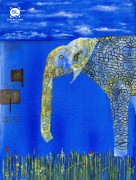What sparks a flash for you? Is it an image, an observation, a memory, something else?
I don’t think there’s any particular thing that sparks a flash for me. Writing is a practice for me, which means I often sit down without anything I intend to work on, and then things come up. Sometimes I open a book at random and read a few lines to see if that sparks something, and often, I pull in elements from my daily life, somewhat reimagined and somewhat straight, and build them into whatever I begin to write. Sometimes something happens—my husband is given a coat or my cat attacks my feet or I read a story in which a woman is thirsty, or I’m walking and I have a vision, and that becomes a starting point, but I never know where it’s going to go.
In your story “Practice,” the characters imagine lives other than the ones they’re living, yet the story is grounded in a scene. How do characters’ inner and outer lives shape your stories?
When I first read your question, I thought, well, in this story, I really just took a moment from my life and made it into a story, because I spend a lot of my life walking. Also, because my husband works outdoors, he usually has time off in the winter and then we walk together. But that’s not really all there is to it. In fact, I have an ongoing interest or preoccupation with this very thing you mention—the relationship between inner and outer lives. When I’m not walking or doing other required activities of living like working, I am often reading, and about five years ago I read Gertrude Stein’s The Making of Americans aloud with my friend Jill, with whom I have been reading aloud for twenty years. I love The Making of Americans; I mean I think I actually fell in love with that book. I may actually have swooned when reading it, and Gertrude Stein spends quite a bit of the book talking about the being inside of each of us, the qualities of that being inside one being living. Combined with my interest in Gaston Bachelard’s ideas about the poetics of space, Chekhov’s statement in “The Lady with the Pet Dog” that the personal lives of every individual are based on secrecy, and spiritual practice, reading Stein led me to what has become an ongoing exploration of imagining the dimensions and physical characteristics of our interior worlds.
But when I wrote “Practice,” I don’t think I was thinking about any of those things particularly. Mainly, I was telling a story that came out of my interaction with my husband and had been reading The Collected Stories of Lydia Davis, a book that I love and often go to for inspiration.
What other writers or writing do you turn to for inspiration?
Mary Ruefle, Anne Carson, Lydia Davis, Leo Tolstoy, Gertrude Stein, Marcel Proust, John Ashbery, Czeslaw Milosz, Haruki Murakami, Siri Hustvedt, Russell Edson, Clarice Lispector, W.S Merwin. I don’t know. So many more. I like to read.
You are also a poet who has two chapbooks and a full-length collection of poems. What relationship do you see between poetry and flash? How did you begin writing flash? In what genres do you feel most at home?
For years and years, I wrote only poetry, but the writers I really loved were those for whom categories didn’t seem that important or easily applied. And I also read a lot of fiction, non-fiction, prose poetry and am pretty deeply interested in visual arts. I remember when I first read Anne Carson’s Short Talks. I fell immediately in love with that book, sort of in the same way I did with Gertrude Stein. Because of these loves, in my writing practice, I think I just went ahead and wrote what I wanted to write and didn’t think too much about what it was or where it fit, whether it was a poem or a story or an essay.
But also, a few years ago, I joined a writing group and I was the only poet, and so I think I may have started leaning more towards flash, which is sort of the poem of story writing, because the writers in that group were more comfortable with fiction than poetry. Also, I remember the day I was Christmas shopping many years ago and was in Barnes & Noble when I came across Lydia Davis’s stories on a sale table. I didn’t know her work at the time, but I was attracted by the physical object of that book, so I picked it up. And I read the first page and ended up buying it for myself for Christmas. Another moment of falling in love. Because those stories are a lot like poems in their size, their compression, the delight they spark. I think, I guess that flash is for me the poetry of story writing, compact, a little bit strange, delightful, bite-sized. And as for me, I just like to write. I don’t really think about genre until it’s time to submit and I have to decide which category to submit under.



 The SmokeLong Grand Micro Contest (The Mikey) is now an annual competition celebrating and compensating the best micro fiction and nonfiction online.
The SmokeLong Grand Micro Contest (The Mikey) is now an annual competition celebrating and compensating the best micro fiction and nonfiction online.